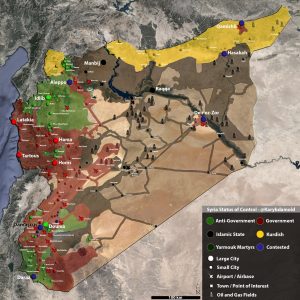
The ISIS ‘caliphate’ is the wild card of Europe’s refugee crisis
The Islamic State terror group has released a barrage of propaganda videos in the past 24 hours targeting refugees and telling them to come join the “caliphate” instead of fleeing to “xenophobic” Europe.
The videos seek to reinforce the image of the “caliphate” — the territory ISIS controls in Iraq and Syria — as an Islamic utopia and capitalise on the dangers refugees face as they flee to European countries.
And these videos aren’t the first propaganda messages ISIS has released about the refugee crisis — earlier this month, in its English-language magazine Dabiq, the extremist group published an article warning against leaving the caliphate for Western countries.
“Sadly, some Syrians and Libyans are willing to risk the lives and souls of those whom they are responsible to raise upon the Sharī’ah — their children — sacrificing many of them during the dangerous trip to the lands of the warwaging crusaders ruled by laws of atheism and indecency,” the article read.
It continued to state that leaving for Western nations is “a dangerous major sin” that is “a gate towards one’s children and grandchildren abandoning Islam for Christianity, atheism, or liberalism.”
This propaganda effort could be a sign of panic in the ranks of ISIS leadership as Iraqis and Syrians flee their respective countries in droves. ISIS relies on residents of its “caliphate” for revenue — it makes most of its money from taxation — and for services that give ISIS-controlled territories the appearance of being a functioning government.
“Taxation certainly would [be] an issue with people fleeing,” Daveed Gartenstein-Ross, a counterterrorism analyst at the Foundation for Defence of Democracies, told Business Insider. “Another significant problem is brain drain … the people who have highly desirable skill sets like doctors are fleeing.
“The oil industry … is another area where they haven’t preserved the level of talent that they need.”
ISIS has targeted doctors and engineers for recruitment to the caliphate so they can provide essential services to the population under ISIS control. Oil is another major source of funding for ISIS, which raked in an estimated $US100 million in 2014 from selling crude on the black market.
Aside from a possible brain drain and loss of revenue if there are fewer people to tax as ISIS continues its attempt to seize territory across Iraq and Syria, the refugee exodus from the Middle East could call ISIS’ legitimacy into question, Gartenstein-Ross said.
“They claim to create this Islamic utopia and Muslims are fleeing in droves,” he said. “A legitimate caliphate … is supposed to be able to provide services to its citizens.”
Some experts, however, disagree with the characterization of ISIS’ media blitz as a sign of desperation or panic.
“I wouldn’t see it as a desperate call for the refugees … because they need people [in their caliphate] but more as a sophisticated move by the Islamic State to take advantage of the huge debate on the refugee movement in Europe,” Pieter Nanninga, an assistant professor of Middle Eastern Studies at the University of Groningen in the Netherlands, told Business Insider.
His research focuses on jihadist violence and media usage, and he viewed the new videos ISIS posted about the refugee crisis.
J.M. Berger, a Brookings Institution fellow and coauthor of the recent book “ISIS: The State of Terror,” echoed this view.
“I think there are some signs on social media that ISIS is concerned with the refugee flows, but it’s possible the leadership’s interest is opportunistic,” he told Business Insider via email. “The rising xenophobia on display at the moment plays very well into their narrative.”
Nanninga sees the Arabic-language videos as a deliberate media campaign targeted at ISIS supporters and sympathizers to promote ISIS’ message of utopia in the caliphate.
“The refugees themselves … I doubt whether they see these videos, I think they will be seen by the supporters of the Islamic State who share these videos on Twitter,” Nanninga said.
The videos use footage of a Hungarian camerawoman who kicked a refugee and images of riots on the Hungarian border to show the dangers of travelling to Europe. These images are juxtaposed with footage of food markets and children happily playing in the caliphate.
Nanninga also noted that the volume of media ISIS has released on the refugee crisis hints that the propaganda is a calculated, sophisticated move to capitalise on the debate surrounding the refugee movement in Europe.
“It’s remarkable that ISIS has launched 10 videos in a bit more than one day, it’s quite unusual,” he said. “The message is quite coherent, so it’s really an orchestrated campaign from different regions in the caliphate.”
Also of note is the fact that most of the refugees streaming into Europe are thought to be fleeing the regime of Syrian President Bashar Assad, who barrel-bombs civilian areas, rather than ISIS specifically.
A people smuggler in Istanbul told Buzzfeed that Assad’s war was “about the only reason for the refugees,” guessing that about 90% of the Syrian refugees he smuggled into Europe were fleeing Assad.
But this might not negate the idea that ISIS could be worried about the caliphate losing its appeal among Syrians and Iraqis.
“If you look at the areas that we consider Assad-controlled territories, a lot of them are actually where the bulk of the fighting is occurring,” Gartenstein-Ross said. “If so, the thing they’re fleeing most is war.”
“It’s the areas that are most disputed where the refugees are coming from … It’s the same patterns you see in any war that has ever occurred. There are still massive amounts of refugees from territory ISIS has taken control of.”
Source: Business Insider





